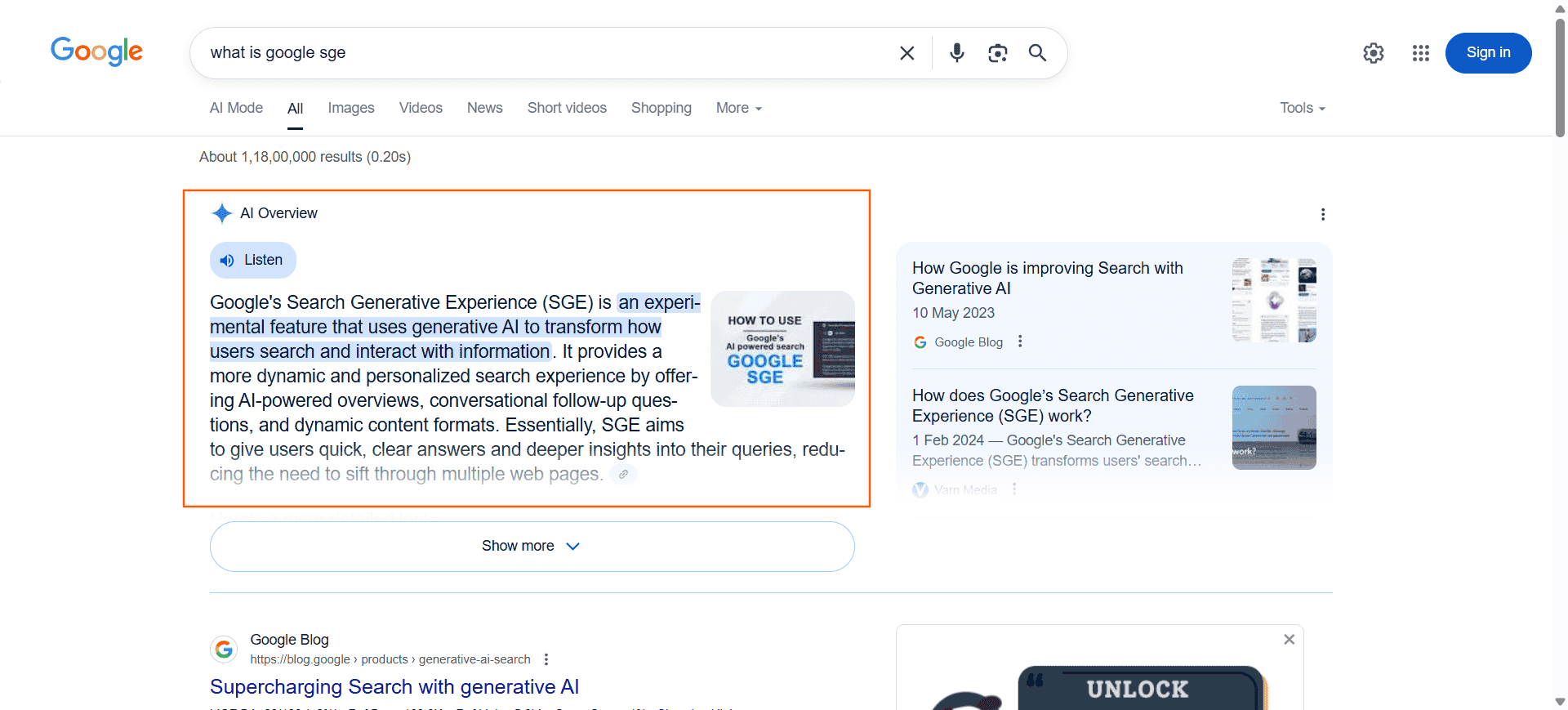How to Optimize for Google SGE: Boost SEO for AI Search Results
Google's Search Generative Experience (SGE) is transforming how users find information online. Instead of just showing a list of links, SGE uses artificial intelligence to generate comprehensive answers directly in search results. This means your content needs to be optimized differently to appear in these AI-generated responses.
If you want your website to be featured in SGE results, you need to focus on three key areas: authority, relevance, and structured content. This guide will show you exactly how to optimize your content for Google's AI-powered search feature.
What is Google's Search Generative Experience?
Google's SGE is an AI-powered feature that creates detailed, conversational answers to user queries by pulling information from multiple sources across the web. When someone searches for something, SGE analyzes relevant content and generates a comprehensive response that appears at the top of search results.
Unlike traditional search results that show individual links, SGE combines information from various sources to create one unified answer. This makes it crucial for websites to optimize their content to be selected by Google's AI systems.

How to Optimize for Google's SGE (Search Generative Experience) in SEO?
1. Target High-Intent, Informational Queries
SGE frequently appears for specific types of searches, particularly informational queries that people ask in natural language. Focus on these query types:
- "How to" queries: "How to fix a leaky faucet step by step"
- "What is" questions: "What is the best way to lose weight"
- "Best" comparisons: "Best smartphones under $500"
- "Why" explanations: "Why do plants need sunlight"
To find these opportunities, use keyword research tools like Google's "People Also Ask" section, AnswerThePublic, or SEMrush. Look for long-tail, conversational keywords that match how people naturally speak and ask questions.
2. Create Comprehensive, High-Quality Content
Your content needs to answer questions directly and thoroughly. Here's how to structure your content for SGE:
- Answer questions immediately: Place your main answer within the first 100 words of your content. Don't make users scroll to find what they're looking for.
- Use clear formatting: Break up your content with bullet points, numbered steps, tables, and FAQ sections. This makes it easier for both users and AI to understand your information.
- Include supporting evidence: Cite authoritative sources, studies, and expert opinions to boost your content's credibility. Google's AI favors content that demonstrates expertise and trustworthiness.
- Write conversationally: Use the same language your audience uses when asking questions. This helps your content align with natural search queries.
3. Optimize for E-E-A-T (Experience, Expertise, Authoritativeness, Trustworthiness)
Google's AI prioritizes content that demonstrates expertise and authority. Here's how to strengthen your E-E-A-T signals:
- Showcase author credentials: Include detailed author bios that highlight relevant experience, education, and expertise. Make sure these are prominently displayed on your content.
- Demonstrate real-world experience: Share personal experiences, case studies, and practical examples that show you've actually done what you're writing about.
- Build authority through backlinks: Earn links from trusted, authoritative websites in your industry. These serve as "votes of confidence" that Google's AI considers when selecting content.
- Use schema markup: Implement Author schema to help Google understand who created your content and their qualifications.
4. Leverage Structured Data (Schema Markup)
Schema markup is code that helps Google understand your content better. For SGE optimization, focus on these schema types:
- HowTo Schema: Use this for step-by-step guides and tutorials. It helps Google extract your instructions for AI-generated answers.
- FAQPage Schema: Perfect for question-and-answer content. This makes it easier for SGE to pull your Q&A pairs.
- Product and Review Schema: Essential for product comparisons and reviews that often appear in SGE results.
- Author Schema: Highlights the expertise and credentials of your content creators.
- Always validate your schema markup using Google's Rich Results Test to ensure it's implemented correctly.
5. Focus on Featured Snippet Optimization
Since SGE often pulls information from featured snippets, optimizing for these traditional SERP features remains important:
- Provide direct answers: Start paragraphs with clear, concise answers to specific questions.
- Use descriptive headers: Structure your content with H2 and H3 headers that match question-based queries.
- Keep paragraphs short: Aim for 40-60 words per paragraph to improve readability and increase chances of being selected.
- Include relevant keywords: Use your target keywords naturally throughout your content, especially in headers and the first paragraph.
6. Improve Page Speed and Mobile Experience
Technical SEO factors directly impact your chances of appearing in SGE results:
- Optimize Core Web Vitals: Focus on Largest Contentful Paint (LCP), First Input Delay (FID), and Cumulative Layout Shift (CLS). These metrics affect user experience and search rankings.
- Ensure mobile responsiveness: SGE heavily favors mobile-friendly pages since many searches happen on mobile devices.
- Compress images: Large images slow down page loading times, which can hurt your SGE visibility.
- Use clean, fast-loading code: Minimize CSS and JavaScript files to improve overall site performance.
7. Monitor Your SGE Performance
Tracking your SGE optimization efforts is crucial for long-term success:
- Use Google Search Console: Monitor impressions and clicks for queries where SGE appears. Look for patterns in which content performs well.
- Track SGE visibility: Use rank tracking tools like Ahrefs or SEMrush to see when your content appears in AI-generated answers.
- Analyze competitor performance: Study which competitors appear in SGE results for your target keywords and analyze their content strategies.
- Monitor user engagement: Track metrics like time on page and bounce rate to ensure your content meets user expectations.
Comparison of SEO, SGE, GEO, and Local SEO Optimization Elements
|
Optimization Element |
SEO (Search Engine Optimization) |
SGE (Search Generative Experience) |
GEO (Generative Engine Optimization) |
Local SEO |
|
Definition |
Optimizes websites for higher rankings in traditional search engine results pages (SERPs) like Google and Bing, focusing on keywords and backlinks. |
Google’s AI-driven feature generating conversational summaries (AI Overviews) above SERPs, synthesizing answers from multiple sources. |
Optimizes content for AI-driven search engines (e.g., ChatGPT, Perplexity, SGE) to be cited in synthesized, conversational responses. |
Optimizes for location-based queries to improve visibility in local search results, like Google Maps or local packs. |
|
Primary Goal |
Rank higher in SERPs to drive organic traffic via clicks. |
Ensure content is cited in AI Overviews to maintain visibility despite reduced clicks. |
Be featured or cited in AI-generated conversational answers for broader reach. |
Appear in local search results and map packs to attract nearby customers. |
|
Keyword Strategy |
Focus on targeted keywords, meta tags, and search intent to rank in top SERP positions. |
Prioritize long-tail, question-based keywords to align with conversational AI summaries. |
Emphasize conversational, context-rich keywords embedded in natural language for AI interpretation. |
Target location-specific keywords (e.g., “coffee shop near me”) to capture local intent. |
|
Content Structure |
Use clear headings, meta descriptions, and skimmable formats to improve user experience and SERP rankings. |
Structured content (e.g., FAQs, lists, summaries) to be easily pulled into AI Overviews. |
Highly structured, concise content with bullet points, tables, and clear hierarchies for AI parsing. |
Include local business details, NAP (Name, Address, Phone), and structured data for local relevance. |
|
Authority Building |
Build backlinks from reputable sites to signal trustworthiness and boost rankings. |
Emphasize E-E-A-T (Experience, Expertise, Authoritativeness, Trustworthiness) to be cited as a trusted source in AI responses. |
Use expert quotes, citations, and statistics to enhance credibility for AI engines. |
Leverage local citations, reviews, and Google Business Profile to establish local authority. |
|
Technical Optimization |
Optimize site speed, mobile-friendliness, and URL structure to improve crawlability and user experience. |
Ensure technical SEO (e.g., schema markup, fast load times) to support AI Overview inclusion. |
Prioritize structured data and mobile optimization for AI engines to parse and cite content accurately. |
Focus on local schema (e.g., LocalBusiness schema) and mobile-friendly site for local search visibility. |
|
User Experience (UX) |
Enhance navigation, reduce bounce rates, and increase dwell time to improve rankings. |
Deliver concise, intent-driven answers to reduce user need to click through, aligning with zero-click trends. |
Provide conversational, engaging content that anticipates follow-up queries for AI and users. |
Optimize for local UX with clear business info, maps, and easy contact options. |
|
Metrics to Track |
Click-through rate (CTR), keyword rankings, organic traffic, and conversions. |
AI Overview impressions, citation frequency, and referral traffic from SGE. |
AI citation frequency, contextual accuracy, and visibility in AI-generated responses. |
Local pack rankings, Google Business Profile engagement, and local traffic/conversions. |
|
Multimedia Use |
Optimize images/videos with alt text and descriptions to rank in Google Image/Video search. |
Use high-quality visuals to enhance AI Overview appeal and context understanding. |
Incorporate visuals (e.g., infographics) to support AI’s content synthesis and user engagement. |
Use local imagery (e.g., store photos) in Google Business Profile to boost local appeal. |
|
Challenges |
Time-intensive; requires constant algorithm updates and backlink management. |
Risk of reduced clicks due to zero-click searches; unclear long-term impact. |
Evolving metrics; harder to quantify ROI due to newness of AI platforms. |
Managing consistent NAP across directories and competing in dense local markets. |
Key Elements for Successful SGE Optimization
To summarize, your SGE optimization strategy should include:
Question-based content: FAQs, how-to guides, and comparison articles
Structured data markup: HowTo, FAQ, Product, and Author schema
Strong E-E-A-T signals: Expert authors, credible sources, and authoritative backlinks
Featured snippet optimization: Direct answers and clear formatting
Technical excellence: Fast loading speeds and mobile optimization
Case Study of Google SGE
1. Healthline - Dominating SGE for Medical & Wellness Queries
Website: https://www.healthline.com
SGE Example Query: "How to lower cholesterol naturally"

Why It Ranks in SGE?
- E-E-A-T (Expertise, Authoritativeness, Trustworthiness) - Articles are medically reviewed by doctors and cite credible sources (NIH, Harvard studies).
- Structured Content - Uses clear H2/H3 headings, bullet points, and FAQ schema markup for easy AI parsing.
- Conversational & Comprehensive - Answers user questions directly (e.g., "Foods to avoid with high cholesterol") in a Q&A format.
- Featured in SGE Carousels - Healthline often appears in "Sources" under AI-generated answers.
Result:
- 50%+ visibility in SGE for health-related queries.
- Increased organic traffic from AI-generated snippets.
2. Wirecutter (NYT) - Winning SGE for Product Comparisons
Website: https://www.nytimes.com/wirecutter
SGE Example Query: "Best wireless earbuds for Android"

Why It Ranks in SGE?
- In-Depth Comparisons - Detailed "X vs. Y" breakdowns with pros/cons (e.g., battery life, sound quality).
- User & Expert-Driven Content - Combines lab testing + real-user reviews (trust signals for Google’s AI).
- Schema Markup - Uses Product, Review, and FAQ schema to help SGE pull data.
- Featured in SGE’s "Product Picks" - Often cited as a source in AI-generated shopping answers.
Result:
- 30% more clicks from SGE-driven product queries.
- Higher conversions due to AI-powered recommendations.
Most Frequently Asked Questions in Google SGE
1. What is Google’s Search Generative Experience (SGE)?
SGE uses AI to create conversational summaries (AI Overviews) above search results, answering complex queries. It’s opt-in via Search Labs, rolled out in the U.S. in May 2024.
- SEO Strategy: Prioritize E-E-A-T and intent-driven content.
2. How does SGE impact organic traffic and SEO?
SGE reduces CTR for informational queries by 50-90% but boosts commercial/local searches via rich displays. Traffic impacts vary (-18% to +219%).
- SEO Strategy: Use structured data, FAQs, and diversify traffic sources.
3. How can I optimize content for SGE?
SGE favors conversational, structured content with long-tail keywords and visuals. Schema markup boosts visibility.
- SEO Strategy: Create in-depth, user-focused content targeting “People Also Ask” queries.
4. Will SGE reduce the value of traditional SEO?
Traditional SEO remains vital but shifts to topical authority. AI Overview links may drive higher CTR, but simple queries lose clicks.
- SEO Strategy: Focus on E-E-A-T, contextual backlinks, and integrated marketing.
5. How does SGE handle different query types?
SGE excels at long-tail, question-based, and commercial queries (86.83% coverage) with summaries or carousels, but skips simple searches.
- SEO Strategy: Target long-tail queries with authoritative content and product schema.
6. How do I get my content cited in SGE’s AI Overviews?
SGE cites authoritative, structured content with clear answers and E-E-A-T signals.
- SEO Strategy: Use FAQ/HowTo schema, scannable formats, and build backlinks.
7. What types of keywords are most effective for SGE?
Long-tail, question-based, conversational keywords (e.g., “how to optimize for AI search”) trigger AI Overviews.
- SEO Strategy: Use tools like AnswerThePublic to target mid-funnel queries.
8. How does SGE affect local SEO and business listings?
SGE enhances local results with map embeds and carousels, boosting optimized listings but reducing generic query traffic.
- SEO Strategy: Optimize Google Business Profiles and use local schema.
9. How can I measure the performance of my SEO in SGE?
Traditional metrics falter; focus on AI Overview impressions, citations, and engagement.
- SEO Strategy: Track long-tail impressions and referrals with tools like Ahrefs.





